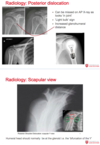Shoulder Joint Conditions Flashcards
How prevalent is a dislocated shoulder? In what population is it most common?
- Approximately 1.7% of the population will experience a dislocated shoulder.
- Bimodal distribution
- 20-30yrs (Males:Females 9:1) - Sports injuries
- 61-80 (Males:Females 1:3) - Falls
- It is less common in children as thier epiphyseal plate is weaker and tends to fracture before dislocating.
- More common in elderly: reduced collagen crosslinking - weaker capsule / tendons / ligaments.
How is the glenohemeral joint stable?
- Congruency of humeral head in glenoid fossa and glenoid labrum
- Negative intra-articular pressure (‘suction cup’ effect)
- Static stabilisers e.g. labrum, joint capsule, extra-capsular ligaments
- Dynamic stabilisers e.g. rotator cuff muscles, long head of biceps brachii
- BUT.. weak inferiorly as there isnt much support.
What are the two types of anterior dislocation of the shoulder?
90% of dislocations are anterior; two subtypes:
- Subcaracoid (60%): Head of humerus lies anterior to glenoid fissa, inferior to caracoid
- Subglenoid (30%): Head of humeus lies antero-inferior to glenoid
Humeral head dislocates antero-inferiorly
Disruption of glenohumeral ligaments
Head pulled anteriorly by muscles (subscapularis, pectoralis major)
How do you anteriorly dislocate your shoulder?
- Hand behind head - Abduction and external rotation
- Trauma pushes arm posteriorly
- Humeral head dislocates antero-inferiorly
OR
- Direct blow to posterior shoudler
What is a Bankart lesion?
A tead of glenoid labrum +/- glenoid fracture
What is a Hill-Sachs lesion?
- Anterior dislocation
- Posterior aspect of jumeral head jammed agaisnt anterior lip of glenoid - Held tightly by mucles e.g. infraspinatus
- Indentation fracture = ‘dent’
- 50% of patients aged under 40 with an anterior dislocation have this lesion
- 80% of patients have a recurrent dislocation have this lesion
How does a posterior shoulder dislocation occur (mechanism)?
- Violent muscle contraction
- Epilectic seizure
- Electrocution
- Lightning strike
- Blow to the anterior shoudler
- Arm flexed across body and pushed posteriorly
How does a patient with a posterior dislocation present?
- Squaring of shoudler (loss of normal contour)
- Arm adducted and internally rotated
- Prominent caracoid process anteriorly
- Humeral head may be prominent posteriorly.
- Arm cannot be externally rotated into anatomical position
How can you use an x-ray to see if a posterior dislocation has occured?
..

What causes inferior dislocation?
Rare = 0.5% cases
Hyperabduction injury - e.g. grasping an object from above to break the fall.
High rate of associated injuries
- Nerves 60%
- Rotator cuff 80%
- Vascular 3%
What are complications of shoulder dislocation?
- Recurrent dislocation
- 60% overall risk
- Risk decreased with age because there is decreased elasticity of the capsule and ligaments.
- Axillary artery damage
- More common in the elderly
- Nerve injury
- Axillary nerve most common
- Cords of brachial plexus
- Other branches e.g. musculocutaneous
- Fractures
- Most common during first-time dislocation
- Humeral head, greater tubercle, clavicle, acromion
- Rotator cuff tears
- More common in elderly and after inferior dislocations
Anatomy of the clavicle
- S shaped bone
- Acts as strut between sternum and glenohumeral joint
- Lateral 1/3 is flat - insertion of trapezius and origin of the deltoid
- Middle 1/3 is tubular - weak to axial load
- Medial 1/3 is quadrangular - insertion of sternocleidomastoid and origin of pectoralis major (clavicular head)
- Protects apex of lung, subclavian vessels and trunks and divisions of brachial plexus.
How do you treat a clavicle fracture?
Most treated conservatively in a sling but sometimes indications for surgical fixations.
When is surgical fixation needed in clavicle fractures?
- Complete displacement
- Severe displacement with tenting of skin (risk of conversion to open fracture)
- Open fracture
- Neurovascular compromise
- Interposed muscle
- Floating shoulder (clavicle and glenoid neck fracture)
What are some complications of clavicle fractures?
- Non-union
- Malunion
- Infection (if open fracture)
- Damage to nerves
- Subrascapular nerve
- Supraclavicular nerves (3 of these)
- trunks and divisions of brachial plexus
- Vascular - Subclavian vein and artery
- Apex of lung - Pneumothorax (air in chest cavity).




